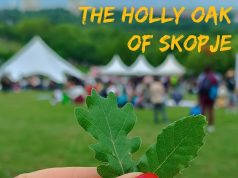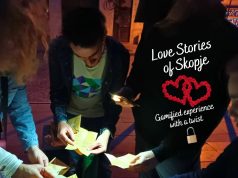Rare discoveries like this don’t happen often, but they aren’t impossible. Two years ago, around this time of year, during our research activities aimed at revitalizing the museum building and the Experience Center of Pivara Skopje, my colleague Aleksandar Madjovski from HAEMUS and I discovered a valuable album with authentic photographs in the archives of the company.
🖼️ The same album we found was previously showcased at the heart of artistic Vienna, Austria, at the Kunsthalle Wien Museumsquartier, as part of the exhibition “No Feeling is Final. The Skopje Solidarity Collection,” presented by the Museum of Contemporary Art Skopje. How did this artifact end up in an exhibition in Vienna, while the original still resides in the museum collection of Pivara Skopje?
📷 The answer is straightforward! There are multiple copies of this album, several of which are also preserved in the Museum of the City of Skopje’s depot. In 1963, these albums were produced by the then “Vijesnik” from Zagreb, Croatia, likely from the original film used to create the authentic photographs. These photographs document the major catastrophe of 1963, illustrating both the tremendous challenges faced by the people of Skopje and the global solidarity and resilience shown by the entire world.
📰 Our original article was first published on July 26, 2023, on the website of Pivara Skopje AD. For more on our company’s history exploration, visit Pivara Skopje’s website and their social media under the hashtag HAEMUS.
SIXTY YEARS SINCE THE SKOPJE EARTHQUAKE – PIVARA SKOPJE DISCOVERS A PRECIOUS ARTIFACT IN ITS ARCHIVES
Contributed by:
Vasilka Dimitrovska, MSc
Aleksandar Madjovski
HAEMUS – Center for Scientific Research and Promotion of Culture
On July 25, 1963, it was a beautiful and warm sunny day, the hottest of the year. The banks of the Vardar River were crowded with sunbathers. As the sun set, the streets of Skopje welcomed their first evening strollers. Skopje residents and numerous tourists sought relief from the summer heat and respite from mosquitoes. In the evening, Radio Skopje concluded its program with the following short news series:
“Today was the hottest day of the year. The beaches along the Vardar were full of sunbathers and a swarm of mosquitoes, for which we thank the sanitation workers who are likely immune to their bites. Tomorrow’s program begins at 5 o’clock with music from records. You will hear the melody of Charles Aznavour – Vivre avec toi… Tomorrow’s weather forecast: sunny and warm… Dear listeners, we wish you a good night.”
On July 26, 1963, at 05:17 in the morning, Skopje was struck by an earthquake with an intensity of 6.1 on the Richter scale. In just 17 seconds, the devastating catastrophe destroyed 85% of residential buildings and over 80% of cultural-historical landmarks that defined the cityscape, leaving thousands under rubble and over 200,000 people homeless. In addition to historic monuments, the earthquake severely damaged most buildings of the university, including libraries, laboratories, the National and University Library, and student dormitories with a capacity of 2,000 beds.
Today, only elderly Skopje residents remember the silhouette of the fortress “Kale,” once a symbol of the city. Before the earthquake, the Historical Museum, located within the former fortress, had just completed its renovation along with newly arranged squares. Surrounding Kale were numerous old shops and the new Stock Exchange. All of this, along with theaters and old houses in the former Jewish quarter, were obliterated in that fateful moment. Significant historical documents from the archive, museum artifacts, and books from destroyed libraries were salvaged by rescue teams and responsible citizens, temporarily stored in the courtyard of St. Spas Church and the Art Gallery in Daut Pasha’s hammam.
Industrial facilities, including Parna Pivara – Skopje, suffered minor structural damage threatening their vital functions. Within two days of the earthquake, the City Assembly decided on emergency measures to revive economic activities. Among the enterprises quickly resuming operations were Skopje’s brewery, together with the glassworks, cement plant “Usje,” “Tsvetan Dimov” factory, Metal Factory “Tito,” “Treska,” and others. However, Parna Pivara – Skopje did not emerge unscathed. According to assessments, production capacities suffered damages of around 169 million old dinars, with additional losses in terms of raw materials amounting to about 45,123 old dinars. Yet, just one year after the earthquake, the brewery ceremonially inaugurated a new production facility — the fifth brew kettle with a capacity of 200 hectoliters per 24 hours, increasing production capacity from the previous 500 to 700 hectoliters per day. In 1964, a trial operation began for a malt brewing plant with a capacity of 3,500 tons. With this investment, the management at the time managed to save about 500 million dinars. These measures were essential for the company to continue as a pillar of the economy in the republic despite the challenging conditions faced by Skopje.
View this post on Instagram
The earthquake was reported immediately by all global media outlets. The German newspaper “Arbeiter Zeitung” dedicated three pages to the earthquake, titled with striking words: “Here was a city called Skopje.” Thanks to the media, not only Yugoslavia but the whole world rallied around Skopje. Alongside state-organized aid from all countries worldwide, archival records highlight numerous ordinary individuals who visited Yugoslav embassies, eager to offer any help they could. Young people, students, and doctors volunteered to assist in Skopje’s reconstruction. Several non-governmental and civil organizations were also mobilized, including Switzerland’s Workers’ Aid, humanitarian organizations from the USA, Austria’s Society of Friends of Children, World Council of Churches, Lutheran World Relief, British humanitarian organization “Fight Against Poverty,” Red Cross, and Red Crescent. Consequently, numerous trucks and flights from European capitals arrived in Belgrade and Skopje with food, medicine, blood plasma, medical supplies, beds, tents, technical equipment, and teams to rescue the injured from the rubble.
Between 1963 and 1964, approximately 14,000 prefabricated homes (known today among locals as barracks) were completed in Macedonia, primarily constructed by then-Yugoslav republics. Whole settlements emerged in Gorce Petrov, Madzari, Zhelezara, Dracevo, Kozle, Zhdanec, Lisice, Vlae, Butel, Przino, Vodno, Acetylene, and Suto Orizari. The United Nations opened a special fund for Skopje’s reconstruction, which included an International Competition for Urban Planning of the city’s central district. In 1965, the winning solutions were those of architect Kenzo Tange from Japan, and Radovan Miscevic and Fedor Venzler from the Institute for Urban Planning in Zagreb. These initiatives shaped the new Macedonian capital and Skopje rightfully earned the title “City of Solidarity,” evidenced by numerous streets named after countries that provided assistance.
In 2009, forty-six years after the catastrophic earthquake, Charles Aznavour arrived in Macedonia as a special guest at the French Film Festival. His song was originally slated to begin the program on Radio Skopje on July 26, 1963. This time, he came to celebrate the 85th birthday of the renowned French artist and the most famous Macedonian beer “Skopsko,” a unique edition released in his honor.
As a socially responsible company, Pivara Skopje actively participated with all its capacities in Skopje’s reconstruction, implementing projects aimed at improving infrastructure, cultural, and sporting life in our capital city and country. Furthermore, the company took proactive steps to preserve and popularize our industrial-cultural heritage through the project for revitalizing the museum building and our Experience Center. It was during these research activities for this center that we unearthed a valuable artifact from 1963 in the company’s archives. This album contains authentic photographs that not only illustrate the challenges faced by Skopje’s residents but also testify to the global solidarity and the strong will of a city to rise again from its ruins, like the mythical Phoenix.
This text has been adapted and revised from the original scientific-research project by HAEMUS titled “Study on the History of Parna Pivara Skopje,” commissioned and supported by Pivara Skopje.
Photo: Archive of Pivara Skopje Archival Sources: St. Clement of Ohrid National and University Library – Skopje, City of Skopje Archives (DARMS – Skopje), Archive of Pivara Skopje








